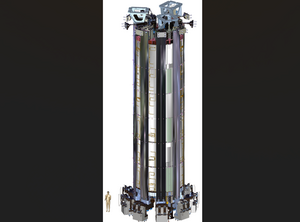Elements of support cage arriving
ITER's six-storey-tall central magnet will require a robust support structure to make sure that it remains secure and aligned in the face of the huge forces at play in the ITER machine. The very first element of the "caging" structure has been delivered by US ITER.
The ITER central solenoid is an 18-metre-tall column at the centre of the machine, formed from six independent magnet windings stacked within a pre-compression support structure.
The different support elements provide a secure base and cage that enables the assembly to withstand thousands of tonnes of force—both pre-load, when forces are applied to the structure to keep vertical gaps and stresses from developing between the modules, and during operation in the face of the machine's internal magnetic forces.
The compression structure also ensures that the tall magnet remains aligned and secure during intensive cycling with peak fields of over 13 Tesla. The support structures must endure high mechanical stresses in the ITER environment, and resist fatigue and crack growth from cycles at cryogenic temperatures.
The supportive "cage" is formed from components made from high-strength, superaustenitic stainless steel (Nitronic 50)—tie plates that run the full height of the central solenoid assembly (9 interior and 18 exterior), which connect at top and bottom to upper and lower "key blocks" weighing up to 6 tonnes each (see image). Procurement is proceeding well in the United States, coordinated by US ITER.
The first lower key block was delivered in February to the ITER site and eight more have been shipped; all 18 upper and lower key blocks will have reached ITER before the end of the year. The fabrication of the tie plates and other support structure components—such as load distribution plates and flex brackets—is underway.



